The original question was: In the ‘60s sci-fi classic “Fantastic Voyage,” the crew of a submarine crew are shrunk to microscopic size and injected into the body of an injured scientist. I realize that this film is rather sloppy from a scientific point of view, but here’s my question: The shrunken crew members are able to see microscopic objects, like white blood cells. But, assuming you could scale a person down, does having smaller eyes necessarily mean you can see smaller – even microscopic — objects? I can’t make out one-point type, even if it is printed clearly through some high-resolution photographic process. Would I be able to if I were the size of an ant? Would scaling down our eyes give them the same capabilities as a microscope?
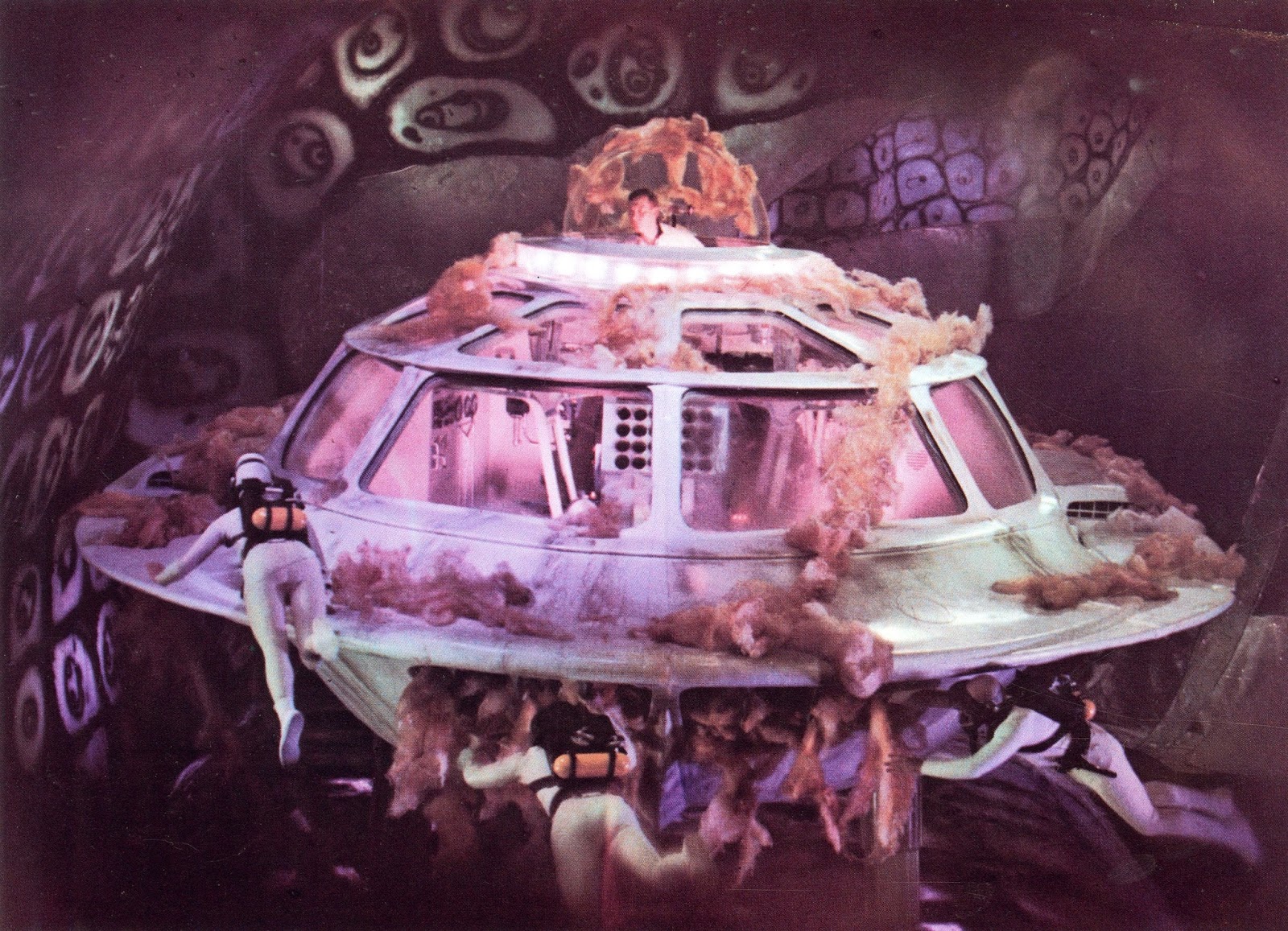
The Fantastic Voyage, 1966.
Physicist: Yes and no, but mostly no. This question basically boils down to: if you were scaled down so that tiny things were large compared to you, would they appear large to your now-tiny eyeballs, with all of their microscopic details made macro?

If you were shrunk down until a Lego brick appeared as large as this sound stage at Estudios Churubusco, then would it literally look like this to your tiny eyes?
The answer is yes: as lenses and eyeballs shrink, the world literally does look bigger. But mostly no: the smaller you get, the darker the world will appear and if you’re shrunk to less than about one 10,000th of your size, the lenses in your eyes will cease to work on visible light.
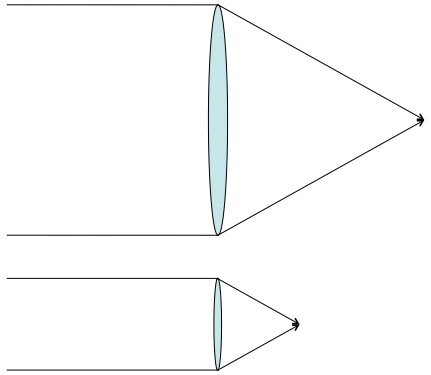
A smaller lens made in the same shape and with the same material will focus light at a proportionately shorter distance. This means that your eyes should continue to work normally; things that are now relatively larger, will appear larger.
The way light interacts with a lens is dictated by the material and the geometry of the lens. Assuming your tiny eyes are the same shape and material as your present eyes (and they always appear to be in the movies), they should work normally. If there’s a cell or Lego brick in front of you and about your size, it will appear to be about your size. You should be able to see smaller details as though the tiny object were literally larger just by walking up to it.
There is an issue. The amount of light bouncing off of tiny things, or flying into tiny eyes, is small. So tiny eyes are always in the dark. Overcoming this problem is why fancy microscopes have light bulbs. Assuming that you, the things you’re interacting with, and the distance to the things you’re interacting with, are all scaled down by the same factor, x (e.g., you’re shrunk and injected into the bloodstream of Dr. Benes), then everything around you will appear to be darker by the inverse square of this factor, x-2. Everything around you would appear to be x times bigger, but the lights would all be x-2 times dimmer.
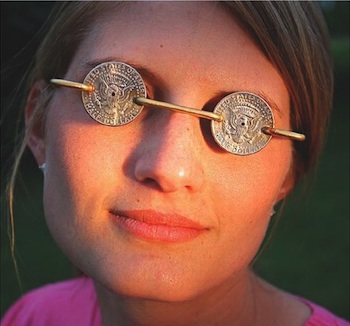
Smaller eyes collect less light. By the time you’re the size of a cell, the amount of light needed for a human eye to see is more than enough to set you on fire.
So if you’re shrunk from being a couple meters tall to being a couple millimeters tall (shrunk by a factor of 103), then the tiny world around you would appear one millionth as bright (decreased by a factor of 10-6). The noon-day Sun would appear about as bright as a full Moon to the milli-you.
In the Fantastic Voyage the ship is shrunk to one micrometer across; a factor of around ten million, 107. The ambient light would need to be one hundred trillion times brighter in order for their environment to have appeared normally lit. If you tried this, you’d see just fine for the fractions of a second before you were cooked. 1014 is a big factor.
Even worse, there’s a diffraction limit brought about by the wave nature of light. Below scales about as large as its wavelength, light starts to act more wavy and less particly. It oozes around corners and ripples around obstacles. In a micro-meter eyeball visible light cannot be relied upon to propagate in a straight line; instead it would splash haphazardly onto your retina. As you shrink through the diffraction limit (assuming there was still enough light to see) the world would get blurrier until it just “blurred out” entirely. Visible light has a wavelength of about half a micrometer and our pupils are around 2 – 5 mm across; about ten thousand times bigger. So, if you were shrunk by a factor of around ten thousand, then you’re eyes will no longer be able to focus incoming light and project it into useful images. You’d basically be in a haze of the average light coming from every direction.
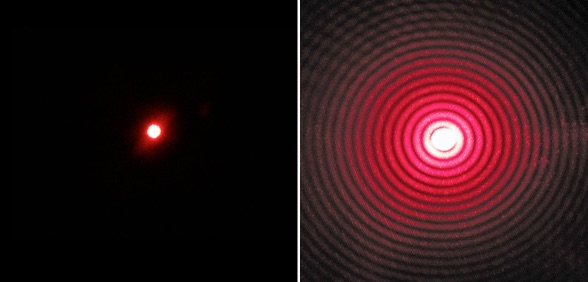
Left: Laser light through a wide aperture. Right: laser light through a very small aperture. The scattering effect of diffraction prevents micrometer scale (or smaller) eyes from being able to form images.
White blood cells are about 10 μm across, or about 20 visible-light-wavelengths. The diffraction limit would start to be an issue when they appear to be about the size of golfballs, and you’d be completely blind when the white blood cells appeared to be about the size of your head.
Despite the difficulties, micrometer sized eyes do exist. But because of the difficulties, they’re crap. Fortunately, the smallest eyes belong to (technically “are”) single celled critters, which are universally too dumb to notice the quality. Synechocystis is cyanobacterium (uses photosynthesis for energy) that’s about 3 micrometers across and uses its entire body as an eyeball. Light passing through the cell focuses a little more in the surface of the cell opposite from the light’s source. This isn’t a trick that’s difficult to evolve; it’s something raindrops do just as well en route to the ground. What makes Synechocystis an “eye” is the fact that it then reacts to that “image”. By swimming away from the bright spot it swims toward the Sun (or any other bright source of light), which is a good move for a critter that eats light. Because of the diffraction limit, this sloppy slightly-brighter-region is about the only image that the tiniest possible eyeball can create and we shouldn’t expect to find eyes much smaller.
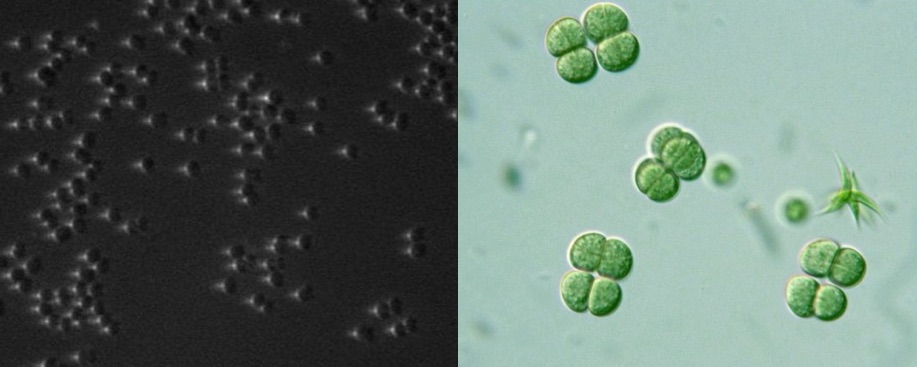
Synechocystis: the smallest, or very nearly the smallest, eyes possible.







Another very excellent and informative article by The Physicist!
There is one novel case where being shrunk down would not necessarily result in difficulty seeing. In the case of the whole universe being shrunk (not just ourselves as is the case presented above) light waves would themselves shrink to a higher frequency, which means their energy level should rise appropriately to maintain intensity. Light might become X-rays, but in accordance, we should then have developed X-ray vision as our retinal cones shorten. I am not sure how long we would survive in such an X-ray environment, however.
Poincare imagined a similar total size change in 1896 in an essay called The Relativity of Space:
https://www.marxists.org/reference/subject/philosophy/works/fr/poincare.htm
By the way, I am not a Marxist. 🙂
Wes
…
depends on the size of the microscope
Wouldn’t the atoms composing the rod and cone cells in your eye also be shrunk, and therefore the wavelength of light visible to you blueshifted?
The above information is very valuable. Yet it doesn’t take into consideration the changes that are bound to take place because of shrinkage. If you assume that you would not be able to see then you also have to consider that no body functions can work at that size. But on the other hand if everything else works it would mean that seeing in microscopic values would be possible. One needs also to take into consideration that our eyes are designed for what we are designed to see in relation to our needs as by design. To explain..an eagle is smaller than us in sizes but by design it sees much further. So what we see is also influenced by what we were designed to see. Hence if shrinking were possible then we would see objects within our scope. One other thing that was over looked, light as we know it is made up of smaller particles than we use at our current size for the requirements needed by our eyes…at smaller sizes only smaller particles are needed and the type of lens would then determine what we are able to see as far as how big or small things look.
…
To Ryan Callahan,
In the example given above by The Physicist, only the dimension of the person would be shrunk. Light would only be “blueshifted” if absolutely everything shrunk including the length of lightwaves (or the magnetic field would be shrunk if one prefers to consider the consequences of a shrunken universe coordinate system).
To Luther David Hall,
Actually the bird may be smaller but an eagle eye is about the same size as a human’s eye.
https://en.wikipedia.org/wiki/Eagle_eye
I proposed that magnetic wavelengths shortened enough would become X-rays whereby “clear glass” type lens would not be necessary. I suppose X-rays should theoretically experience a lens type diffraction from substances that are opaque to ordinary light wavelengths.
I believe there may a limit to the shortness of useful wavelength dictated by “Planck length” ( https://en.wikipedia.org/wiki/Planck_energy ) in conventional science. The Heisenberg’s uncertainty principle ( https://en.wikipedia.org/wiki/Uncertainty_principle ) begins to rear it’s ugly head. The more we know, the harder it is to write plausible science fiction. 🙂
Wes
…
glad to see you’re back, love your work mate!!
The way I see it, as the question is the following:
“If you were shrunk to microscopic size would you be able to see normally? Would you be able to see microscopic things?”
We have to face the fact that there is a limit to how small a living thing can be created by “God” as the kind of organisms that we are at present, in particular made up of cells, and most importantly equipped with the kind of eyes we have at present, also made up of cells the kind we have at present.
The limit is the smallest size beyond which a living thing with eyes cannot come into existence, as we judge from our knowledge of organisms composed of cells and equipped with eyes as we have them actually now, eyes also composed of cells.
My point is that all reports of empirical evidence i.e. from our eye sighting, of the existence of sub-atomic particles, they are all founded on inference from mathematics, based on for example the double-slit experiment in which particles can be seen as particles or as waves – to our eyes, of course with the aid of basically optical detection equipment.
I seem to have read that molecules can be magnified with essentially optical inventions, by which the light rays coming from the molecules become visible to our eye sight.
But I am always asking scientists this question: When you magnify the image of an object, like say, a bunch of molecules which are supposed to be composed of atoms, do we not have to first narrow down to smaller and smaller the size of the molecule cluster, we accordingly want to magnify the light rays coming from the reduced cluster, and wherefore the number of molecules become lesser and lesser as the portion size is further reduced?
I will give this example of a text of words which are so small like the report of some text written in a grain of rice: to see the words on the surface of the grain of rice, you have to reduce the number of words, so that perhaps at the end you get to see only one letter at a time, because to still further reduce the image, you will not see any letter at all but a part of a letter, and you cannot make out what is that letter.
Besides, to magnify the text image even further just for experiment, the light rays coming to your eyes become less and less and less, so at one point it is no longer visible light for its energy is so dissipated, as to exceed beyond the sensibility of our eye cells whatever.
That is why I always say to myself that all these reports about empirical sighting of sub-atomic particles are just all inferential accounts, based on the their effects in the macroscopic world, effects which are visible to our macroscopic eyes, but not the sub-atomic particles as they exist in time and in space beyond our inferential prowess.
So in layman’s terms, it would have the effect of closing up the aperture on a camera lens.
Would the opposite have an opposite impact? Would increasing your size to the same degree (assuming the Earth and its atmosphere can contain you), would you be blinded by the amount of light pouring into your retina?
What effect would this have on you do you think?
This reminds me of synchrotron light sources, which take the place of a light bulb for very powerful microscopes. The light coming off the synchrotron’s electron beam is so intense and energetic, the wavelength is short enough to resolve smaller details before hitting a diffraction limit. Also, there is enough of this light in a small area so all the light reflecting off nanoscopic features can be detected.
A synchrotron light source’s light is so powerful, facilities that produce and use it have to take extra precaution around this radiation.
of course. all things are relative including time and space. even the speed of light, which is NOT a constant. the world will catch up and wake up someday to this truth. yes, you would not know the difference, were you proportionately shrunk down to a tiny level. what you would experience would not be what we would viewing that size, from here.
Interesting Stuff!
Pingback: What If You Could Shrink to the Size of an Atom? | What If Show
While the light intensity diminishes with distance as you shrink the distance you could be from an object you would be looking at is also shrunk. The smaller you shrink the closer you could get to an object requiring less light. You would be illuminating a microscopic area from a microscopic distance.
If we brought a light would the wavelength it produced shrink as it shrank and would your shrinking eyes be able to detect the shrinking wavelength?
Would the range of “visible light” change to your shrinking eyes? Would you see at a different wavelength? How would your brain interpret what your eyes see?
I will go into to a girls big but